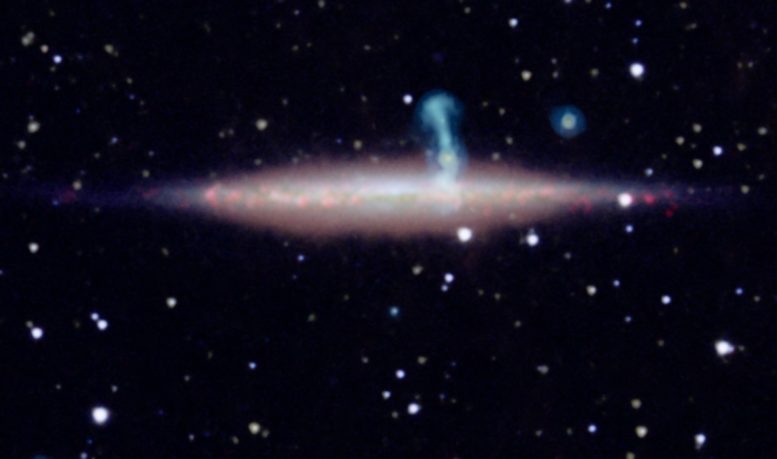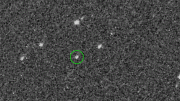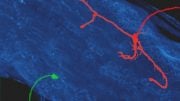
The edge-on spiral galaxy UGC 10288 appeared to be a single object in previous observations. However, new detailed radio data from the NRAO’s Jansky Very Large Array (VLA) revealed that the large perpendicular extension of UGC 10288’s halo (blue) is really a distant background galaxy with radio jets. Credit: VLA/NASA/JPL-Caltech/SDSS/NOAO/University of Manitoba
New detailed radio data has revealed that what scientists thought was spiral galaxy UGC 10288 is actually two galaxies, one lying behind the other.
What might look like a colossal jet shooting away from a galaxy turns out to be an illusion. New data from the National Science Foundation’s Karl G. Jansky Very Large Array (VLA) reveal that two galaxies, one lying behind the other, have been masquerading as one.
In a new image highlighting the chance alignment, radio data from the VLA are blue and infrared observations from NASA’s Spitzer Space Telescope and Wide-field Infrared Survey Explorer (WISE) are yellow and orange, respectively. Visible data are also shown, with starlight in purplish blue and heated gas in rose.
The closer galaxy, called UGC 10288, is located 100 million light-years away. It is spiral in shape, but from our viewpoint on Earth, we are seeing its thin edge. The farther galaxy, seen in blue, is nearly 7 billion light-years away. Two giant jets shoot away from this galaxy, one of which is seen above the plane of the closer galaxy’s disk.
Earlier radio images of the two galaxies appeared as one fuzzy blob, and fooled astronomers into thinking they were looking at one galaxy. Thanks to the VLA pulling the curtain back on the disguised duo, the scientists have a unique opportunity to learn otherwise unobtainable facts about the nearer galaxy.
“We can use the radio waves from the background galaxy, coming through the nearer one, as a way to measure the properties of the nearer galaxy,” said Judith Irwin, of Queen’s University, Canada, lead author of a recent paper on the findings, appearing online November 15 in the Astronomical Journal.
Observations from Spitzer and WISE helped to reveal new structures above and below the plane of the closer galaxy’s disk. For example, Spitzer helped confirm an arc-like feature rising more than 11,000 light-years above the disk, which was seen in the radio observations.
Reference: “CHANG-ES. III. UGC 10288—An Edge-on Galaxy with a Background Double-lobed Radio Source” by Judith Irwin, Marita Krause, Jayanne English, Rainer Beck, Eric Murphy, Theresa Wiegert, George Heald, Rene Walterbos, Richard J. Rand and Troy Porter, 15 November 2013, The Astronomical Journal.
DOI: 10.1088/0004-6256/146/6/164
Irwin worked with an international team of astronomers from North America, India, and Europe who are part of the “Continuum Halos in Nearby Galaxies — an EVLA Survey” (CHANG-ES) consortium.
The National Radio Astronomy Observatory is a facility of the National Science Foundation, operated under cooperative agreement by Associated Universities, Inc.
NASA’s Jet Propulsion Laboratory, Pasadena, California, manages the Spitzer Space Telescope mission for NASA’s Science Mission Directorate, Washington. Science operations are conducted at the Spitzer Science Center at the California Institute of Technology in Pasadena. Spacecraft operations are based at Lockheed Martin Space Systems Company, Littleton, Colorado. Data are archived at the Infrared Science Archive housed at the Infrared Processing and Analysis Center at Caltech. Caltech manages JPL for NASA.
JPL manages and operates the WISE mission for NASA’s Science Mission Directorate. The WISE mission was selected competitively under NASA’s Explorers Program managed by the agency’s Goddard Space Flight Center in Greenbelt, Md. The science instrument was built by the Space Dynamics Laboratory in Logan, Utah. The spacecraft was built by Ball Aerospace & Technologies Corp. in Boulder, Colorado. Science operations and data processing take place at the Infrared Processing and Analysis Center at Caltech. Caltech manages JPL for NASA.









Be the first to comment on "New Data Reveals Two Galaxies Masquerading as One"